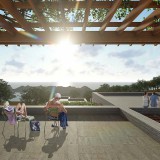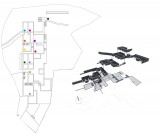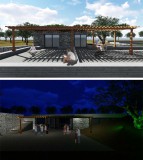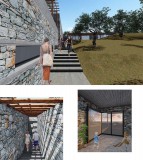This dissertation examines summer housing in the Greek islands . It focuses on 6 acres of land close to Patitiri of Alonnisos with a strong altitudinal fluctuation of 25 metres.
The key principle applied to this study was the creation of a structure that is in harmony with the environment it is located in. The structure is in the form of bunker, which reveals its form on the slope of Patitiri. Furthermore, a traditional method of masonry was applied to the structure in order to match its natural surroundings. The use of stone from the nearby island of Peristera, in conjunction with elements of concrete and rock fills in gabions, made from the same type of stone in order to withhold the slanted surface, led to the creation of a structure that does not contrast with theterrain it is placed in.
The above resulted in the creation of a public building and ten housing units, each with its own plot of arable land, which bring their inhabitants in direct contact with the environment. Each inhabitant is called upon to produce the vegetables they consume in a harmonious coexistence with the natural environment that surrounds them.This is achieved with the use of rainwater collection tanks, with sufficient capacity to cover the cultivation needs for the entire summer period.
The housing unit complex acts as a refuge for the modern man away from his artificial environment. Through this experience, man comes in contact with the subsoil and arable land, reminding him of his primary role: he is part of nature, not its master. He therefore needs to respect nature and its particularities and coexist harmoniously with it.







